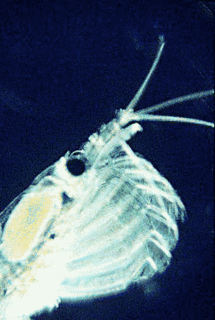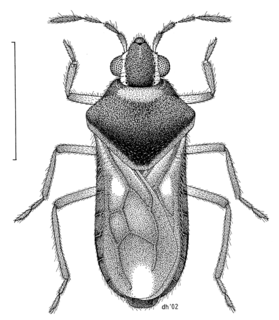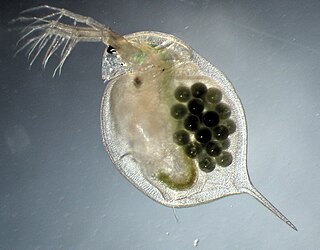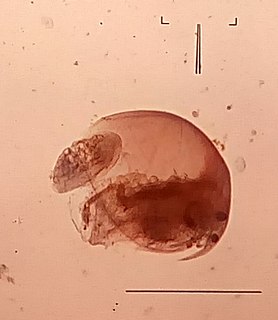
Branchiopoda is a class of crustaceans. It comprises fairy shrimp, clam shrimp, Cladocera, Notostraca and the Devonian Lepidocaris. They are mostly small, freshwater animals that feed on plankton and detritus.

Daphnia is a genus of small planktonic crustaceans, 0.2–6.0 mm (0.01–0.24 in) in length. Daphnia are members of the order Cladocera, and are one of the several small aquatic crustaceans commonly called water fleas because their saltatory swimming style resembles the movements of fleas. Daphnia spp. live in various aquatic environments ranging from acidic swamps to freshwater lakes and ponds.

Centipedes are predatory arthropods belonging to the class Chilopoda of the subphylum Myriapoda, an arthropod group which also includes millipedes and other multi-legged creatures. Centipedes are elongated metameric creatures with one pair of legs per body segment. Most centipedes are venomous and can inflict painful bites, injecting their venom through pincer-like appendages known as forcipules. Despite the name, centipedes can have a varying number of legs, ranging from 30 to 354. Centipedes always have an odd number of pairs of legs. Therefore, no centipede has exactly 100 legs. Like spiders and scorpions, centipedes are predominantly carnivorous.
In chemistry, a mixture is a material made up of two or more different chemical substance/substances which are not chemically combined. A mixture is the physical combination of two or more substances in which the identities are retained and are mixed in the form of solutions, suspensions and colloids.

Filter feeders are a sub-group of suspension feeding animals that feed by straining suspended matter and food particles from water, typically by passing the water over a specialized filtering structure. Some animals that use this method of feeding are clams, krill, sponges, baleen whales, and many fish. Some birds, such as flamingos and certain species of duck, are also filter feeders. Filter feeders can play an important role in clarifying water, and are therefore considered ecosystem engineers. They are also important in bioaccumulation and, as a result, as indicator organisms.

Mysida is an order of small, shrimp-like crustaceans in the malacostracan superorder Peracarida. Their common name opossum shrimps stems from the presence of a brood pouch or "marsupium" in females. The fact that the larvae are reared in this pouch and are not free-swimming characterises the order. The mysid's head bears a pair of stalked eyes and two pairs of antennae. The thorax consists of eight segments each bearing branching limbs, the whole concealed beneath a protective carapace and the abdomen has six segments and usually further small limbs.

Symphylans, also known as garden centipedes or pseudocentipedes, are soil-dwelling arthropods of the class Symphyla in the subphylum Myriapoda. Symphylans resemble centipedes, but are very small, non-venomous, and only distantly related to both centipedes and millipedes. They can move rapidly through the pores between soil particles, and are typically found from the surface down to a depth of about 50 centimetres (20 in). They consume decaying vegetation, but can do considerable harm in an agricultural setting by consuming seeds, roots, and root hairs in cultivated soil.

Clam shrimp are a taxon of bivalved branchiopod crustaceans that resemble the unrelated bivalved molluscs. They are extant, and known from the fossil record, from at least the Devonian period and perhaps before. They were originally classified in a single order Conchostraca, which later proved to be paraphyletic, being separated into three different orders: Cyclestherida, Laevicaudata, and Spinicaudata, but excluding the fairy shrimp (Cladocera), which are most closely related to the Cyclestherida.

Anostraca is one of the four orders of crustaceans in the class Branchiopoda; its members are also known as fairy shrimp. They live in vernal pools and hypersaline lakes across the world, and they have even been found in deserts, ice-covered mountain lakes and Antarctic ice. They are usually 6–25 mm (0.24–0.98 in) long. Most species have 20 body segments, bearing 11 pairs of leaf-like phyllopodia, and the body lacks a carapace. They swim "upside-down" and feed by filtering organic particles from the water or by scraping algae from surfaces. They are an important food for many birds and fish, and some are cultured and harvested for use as fish food. There are 300 species spread across 8 families.

The caddisflies, or order Trichoptera, are a group of insects with aquatic larvae and terrestrial adults. There are approximately 14,500 described species, most of which can be divided into the suborders Integripalpia and Annulipalpia on the basis of the adult mouthparts. Integripalpian larvae construct a portable casing to protect themselves as they move around looking for food, while Annulipalpian larvae make themselves a fixed retreat in which they remain, waiting for food to come to them. The affinities of the small third suborder Spicipalpia are unclear, and molecular analysis suggests it may not be monophyletic. Also called sedge-flies or rail-flies, the adults are small moth-like insects with two pairs of hairy membranous wings. They are closely related to the Lepidoptera which have scales on their wings; the two orders together form the superorder Amphiesmenoptera.

Veliidae is a family of gregarious predatory insects in the suborder Heteroptera. They are commonly known as riffle bugs, small water striders, or broad-shouldered water striders because the segment immediately behind the head is wider than the rest of the abdomen. The genus Rhagovelia is also referred to as a ripple bug.

The silver carp is a species of freshwater cyprinid fish, a variety of Asian carp native to China and eastern Siberia, from the Amur River drainage in the north to the Xi Jiang River drainage in the south. Although a threatened species in its natural habitat, it has long been cultivated in China. By weight, more silver carp are produced worldwide in aquaculture than any other species of fish except for the grass carp. Silver carp are usually farmed in polyculture with other Asian carp, or sometimes with catla or other fish species.

The Cladocera, commonly known as water fleas are an order of small crustaceans that feed on microscopic chunks of organic matter.

Daphniidae is a family of water fleas in the suborder Anomopoda.

Halobates or sea skaters are a genus with over 40 species of water striders. Most Halobates species are coastal and typically found in sheltered marine habitats, but five live on the surface of the open ocean and only occur near the coast when storms blow them ashore. These are the only known truly oceanic, offshore insects. They are found in tropical and subtropical marine habitats around the world, with a single species recorded in rivers a few kilometers upstream from the ocean. Halobates are generally very common.

Daphnia magna is a small planktonic crustacean that belongs to the subclass Phyllopoda. It inhabits a variety of freshwater environments, ranging from acidic swamps to rivers made of snow runoff, and is broadly distributed throughout the Northern Hemisphere and South Africa.

Leptodora is a genus containing two species of large, nearly transparent predatory water fleas. They grow up to 21 mm (0.83 in) long, with two large antennae used for swimming and a single compound eye. The legs are used to catch copepods that it comes into contact with by chance. Leptodora kindtii is found in temperate lakes across the Northern Hemisphere and is probably the only cladoceran ever described in a newspaper; L. richardi is only known from eastern Russia. For most of the year, Leptodora reproduces parthenogenetically, with males only appearing late in the season, to produce winter eggs which hatch the following spring. Leptodora is the only genus in its family, the Leptodoridae, and suborder, Haplopoda.

Polyphemus is a genus of water fleas, and the only genus in the family Polyphemidae. There are two species, P. exiguus and P. pediculus, although allopatric speciation has resulted in a number of cryptic species of P. pediculus. Polyphemus exiguus inhabits open zones in the Caspian Sea, while Polyphemus pediculus exists throughout the Holarctic. It lives in diverse conditions, from small ponds to lakes and estuaries such as the Gulf of Saint Lawrence and the Gulf of Finland. It can be found quite far offshore.

Daphnia longispina is a planktonic crustacean of the family Daphniidae, a cladoceran freshwater water flea. It is native to Eurasia. D. longispina is similar in size and sometimes confused with the often sympatric D. pulex, but much smaller than D. magna. D. longispina is found in a wide range of standing freshwater bodies from small, ephemeral rock-pools to large lakes.

Bosminidae is a family of anomopods in the order Diplostraca. There are at least 3 genera and 40 described species in Bosminidae.


















